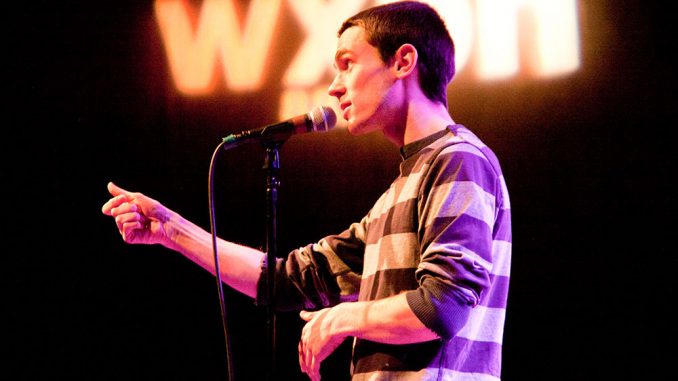
After a song by math-rock band American Football, Philadelphians are treated to a taste of classic folk tradition that’s a bit different from the traditions of house-show music – personal stories told before a live audience, later broadcast on the radio.
Last week, radio audiences heard a few seconds of censor bleep for Iggy Pop’s phone number. Ameera Chowdhury, a professor at Carnegie Mellon University, shared the punk star’s number during her story of her phone conversations with Iggy Pop when she was 17 years old.
“This is that thing you throw peanuts at. Take a shot, sucker,” Iggy Pop’s answering machine went, according to Chowdhury.
The Moth, where Chowdhury told her tale of teenage lust, started as story swapping on a porch on sweltering summer nights in Georgia. Since then, The Moth has grown to a nationwide storytellers’ collective with about 200 public radio stations blasting its “Radio Hour” over the airwaves each week.
George Dawes Green, a Georgia-born poet and winner of the 1995 “Best First Novel” award, called his storytelling and porch-dwelling friends “The Moths.” Green dropped the “s” in 1997 when he moved to New York City, holding more story swapping events in living rooms and later in clubs to accommodate the growing crowds.
WXPN recently picked up the radio incarnation of Green’s tradition, broadcasting the Peabody Award-winning “The Moth Radio Hour” every Tuesday at 10 p.m.
“I have been a fan of The Moth since it began and always wanted to put it on XPN,” said Bruce Warren, assistant general manager for programming and 22-year veteran at WXPN. “Those who know XPN know that we’re primarily a music station, but I always felt [The Moth] could fit in on the airwaves here.”
It also fits on the station because it seems to be a growing trend across the city.
“Philly has a robust storytelling, spoken word, and poetry community – anchored in part by what the folks at First Person Arts have been doing,” Warren said. “So connecting with the spoken word community on the radio and in person for events seemed to make a lot of sense.”
A typical show consists of three to five personal stories with a message.
“Our shows feature storytellers from all walks of life,” said Sarah Austin Jenness, producing director for The Moth. “You’ll have a homeless man, a doctor, a celebrity.”
In addition to the Radio Hour, The Moth holds events in American cities. Jenness, who joined The Moth in 2005, said the visits to other cities became a necessity as the program grew and people from outside New York expressed interest in sharing stories.
“It was tough to get them all to New York, so we figured we’d go to them,” Jenness said.
The two main events are Mainstage events, which feature stories from bigger names like Jonathan Ames, creator of HBO series “Bored to Death,” and Adam Savage of “MythBusters” fame.
The other type of event, called a “StorySLAM,” is held weekly in New York City and at least once a month in other major cities, including Philadelphia.
At the open-mic StorySLAMs, audience members can tell stories to three judges who are also selected from the audience and will pick the night’s winner. The story must be five minutes long and fit in with the night’s theme. After enough StorySLAM winners are picked from one city, they can go on to a GrandSLAM to compete among the best from their city.
“The show is built out of the open mic aspect,” said StorySLAM manager Robin Wachsberger, a self-described “slamhead” who used to tell stories of her own to The Moth. “It’s not like standup where you hide behind a persona. There’s a light charm to it, there’s no bells and whistles. It’s just a microphone, a stage and a crowd.”
Jenness, who used to work in theater and on documentaries, called The Moth “an intersection of a documentary and a play.”
While many of the stories can be humorous, others can be quite powerful. Paul Teodo, a hospital administrator in Chicago, told a story of one of his hitchhiking adventures, when he got a ride with serial killer John Wayne Gacy. Teodo did not learn it was Gacy until years later, but recalled that Gacy asked for sexual favors and he only escaped after threatening to take the wheel and crash the car, killing them both.
“What I expected was that there would be an audience for the show – it would bring in some new listeners and our current listeners would discover how powerful the show is,” Warren said. “All signs seem to be pointing in the right direction here.”
Joe Brandt can be reached at jbrandt@temple.edu or on Twitter @JBrandt_TU.


Be the first to comment